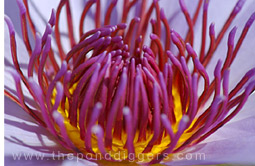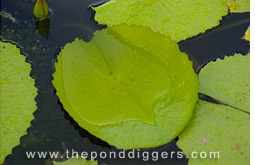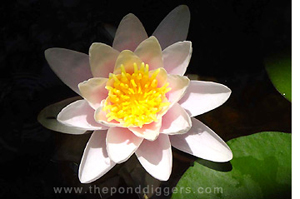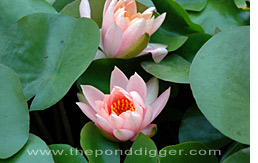Water Lilies, Popular Aquatic Pond Plants
Water lilies – or Nymphaea, to scientists – are considered by many to be the jewels of the pond. Not only are they beautiful to look at, but they also serve an important purpose in the pond, mainly in aiding its ecosystem. Water lilies spread across the water‘s surface, filling it with color and vibrancy all the while keeping the pond and the creatures in it safe and healthy. produce. Besides being pleasing to the eye, water lilies do a great deal to maintain the well-being of the ponds they inhabit. For one, they provide shade to keep the water temperature down during the hot summer months. By blocking out a lot of sunlight, the lilies help to keep the algae growth down. Their shade also gives shelter to any fish that may be in the pond – a respite from both the sun and any predators that may be lurking nearby. They also absorb nutrients in the water that would normally feed these undesirable green plants, keeping the water clear and clean-looking. |
General InformationHardy water lilies can remain in the pond year round. The lily will die off in the winter time and produce new leaves and flowers in the spring. The hardy lily generally flowers from May through September. Flowers come in a variety of colors, opening in the early morning and closing in the late afternoon. Some hardy water lily flowers change color shades over the life of the bloom Water lilies grow completely within water, with their blossoms flourishing on top of or above the water’s surface. They typically grow to suit the size of the area in which they are placed, spreading their leaves across the surface of the water and filling it with color. Water lilies require a lot of sun to grow properly. In frost-free regions, they bloom all year. In cooler regions, they bloom during the summer and often into the fall. Throughout their growing season, they constantly generate leaf growth. These leaves live up to three or four weeks at the peak of the season. The most striking feature of water lilies is the incredible amount of variation found among the different plants. From their shape and size, their color and fragrance, or their blooming patterns and growing periods, there is a water lily for every preference and every pond. Water lilies range notably in size – from miniature flowers with small leaves to giant plants that spread over 25 square feet. They come in a variety of shapes – star shaped, cup shaped, pointed or fluffy, though that’s certainly not all. The leaves can be smooth or jagged, rounded or pointed. The colors are just as varied, ranging from yellow, pink, red, white, purple, blue and orange. Several types of lilies are incredibly fragrant, as well. |

In the center of all water lilies are golden stamens – the organ of the flowers that bear pollen. When the lilies are young, the stamens stand straight. As the flowers age, they begin folding and curling into the flower. The variations found in water lilies are especially pronounced when one breaks down the genus further, into hardy water lilies and tropical water lilies. They are similar, but they are not closely enough related to be naturally cross-bred. While both need a lot of sun to bloom and to thrive, tropical‘s, unlike hardies, can still bloom with as little as three hours of sun in a day. That said, tropical water lilies can be either day- or night-flowering plants, while hardies only open during the daylight hours. Tropical water lilies also start blooming later in the summer than hardies; however, they remain in bloom for longer than hardies. Tropicals also tend to have larger plants and larger blossoms than their hardy counterparts, and tend to hold their blossoms higher above the water than do the hardies. These are a few of the differences between the two types, but the list continues. Both subgenres – hardy water lilies and tropical water lilies – have their own characteristics and their own needs, as outlined below. |
Hardy Water Lilies
The leaves of hardy plants are circular in shape with smooth, round edges. There is a waxy cuticle covering their surface. These features all aid in their survival: the shape helps to protect them from tearing in rough winds or waves, while the waxy cuticle allows the water to roll off the surface so that the leaves do not sink. Hardies come in a variety of colors, ranging from red, salmon, pink, white, yellow, orange, peach and nearly black. There are some varieties– called changeable water lilies – that change their color over their bloom period (of three to four days). Hardy water lilies are the first of the lilies to come into bloom in the spring. Once the water temperature holds steady at 60 degrees, they will begin to bloom, spreading their pads across the pond with their blossoms eventually floating on or just above the water’s surface. These shallow-rooted plants need plenty of room to grow and spread up and out across the pond. In the early spring, these fresh lily pads will begin to emerge on the water’s surface. Many of the lilies will be in bloom by mid- to late-spring. They bloom throughout the warm-weather months, eventually becoming dormant in the fall. These are perennial plants, meaning that as long as the rhizome – the underground stem that sends out roots and shoots – does not freeze, the plant will survive through the winter and bloom again in spring. Come winter, in areas with no frost, they will continue to grow, however their growth will certainly slow down a bit. Year-round blooming is possible in frost-free zones. In areas with frost, however, the lilies survive through the winter only if they are below the pond ice. These are not night-blooming flowers. Indeed, they are open in full bloom by mid-morning and are closed again by mid- to late-afternoon. Though each flower will last approximately three to five days, new flowers will constantly open throughout the season. |
Tropical Water Lilies
The lily pads of the tropical plants come in different shapes, typically smooth, toothed or fluted. The edges are usually jagged and pointed and may even look ruffled. The pads are larger than the hardies, often taking up much more space in the water than they do. A tropical’s blossoms are impressively sized – some span more than a foot across. Like the hardies, they come in many different colors. The two subgenres share the same color palette, for the most part (red, salmon, pink, white, yellow, orange, peach and near-black), but these types also come in blue and purple. Though hardy water lilies are indeed very beautiful flowers, it is the tropical lilies that command – and capture – the most attention. They are larger and flashier than the hardies and tend to be more fragrant. They also tend to bloom for a month or two longer, stay open later in the day, and are more likely than hardies to produce multiple flowers at any given time. Tropical‘s require warmer temperatures than do the hardies to bloom, thus making them a bit more difficult to grow. After three or more weeks of temperatures above 80 degrees, these flowers will finally start to open up and bloom. Once they do, they fill the ponds with their colorful blossoms throughout the summer months and well into fall. After the hardies have gone dormant, tropicalswill stay in bloom for several weeks longer, often until the first frost. During the winter months, however, they go dormant and die. |

There are two kinds of tropical water lilies: night bloomers and day bloomers. Lilies in the white, pink or red color range tend to be night bloomers, and these types are typically more fragrant. These flowers can take an entire hour to fully open, and tend to open in the late afternoon or early evening and close the following mid-morning. Day bloomers, however, are the most common kind of tropical water lilies. They are fragrant, as well, but their scents are usually lighter and sweeter than the heavy-scented tropicals. Day bloomers have pointed petals and come in various shades, from magenta, red or pink, to white or yellow, or to blue or violet. They open midmorning and close again during the late afternoon hours. The blooms of both day and night bloomers open and close for periods of three to four days, holding their flowers above the water on strong, stiff stems. |
Planting and MaintenanceThere are two options when it comes to planting water lilies. They can either be planted in aquatic plant pots (the kind with no holes in the bottom) or directly in a hole created at the bottom of the pond. The planting of the lily itself will not be affected by the method you choose. Once you determine whether to use plant pots or plant pockets, you can begin the whole process. With plant pots, a hole is created in the bottom of the pond into which the pots will be placed. These holes at the bottom of the pond must be able to accommodate the pot, so it is important that they are deep and wide enough. Once the vessel has been chosen and the lilies have been planted, you can place the pot into the hole. Take heed: the pot must lie directly on top of the soil at the bottom of the hole on level ground. “If you choose to use the pocket method, you will plant the water lilies directly into the hole at the bottom of the pond.” The size of your pond will determine the size of the container you use or the hole you dig. Again, lilies grow to suit the size of the area they are in – keep this in mind. As a rule, the larger the vessel, the larger the lilies will grow. Water lilies thrive best in heavy garden topsoil, but take care to make sure it has not been mixed with other substances such as manure or compost. Maintaining the well-being of the lilies is vital for keeping ponds beautiful. Lilies should be fertilized regularly. This will help the flowers to grow larger and to bloom more frequently. You also must take care to remove all dead or yellowing leaves from the plant’s surface so they will not sink to the bottom and decompose. You should also keep the stems trimmed, pruning them as close to the rhizome as you are able. There are some differences between hardies and tropicals, however, in terms of their planting and maintenance. Hardies Ideally, you should set your hardy lilies out once the early spring chill has subsided but before they begin growing. Doing so will enable them to produce blooms their first summer. If you buy the rhizomes before you can plant them, keep them submerged in water and leave them in a cool place and away from directly sunlight. These lilies should be planted in pots or holes six to eight inches deep or in pots of a nine- to 20- (or more) quart capacity. The smallest pots recommended for standard and larger sized lilies are nine- to 10-quart containers. At least a five-quart container is recommended for the smaller lilies. Fill the container about one-third of the way with topsoil then place the seed on top. Then cover the seed with soil so that the tip is just barely peeking through the soil. The blossoms of hardies will rise to the surface one at a time every three to seven days. Maintenance is key, especially with hardies whose leaves continuously die and grow back throughout the growing season. Yellow leaves and four-day-old blossoms should be removed regularly. You should stop fertilizing hardy lilies in the early fall season as the growth of the plant slows. After the first frost, you should remove about two-thirds of the foliage. Hardy lilies can live through the winter, but special care must be given to them during this time. In cold regions, they will survive if they are below the ice. If the pond isn’t deep enough to lower the containers as needed, remove the pans with the lilies in them and take them to a cool location. Keep them covered with damp material, such as a damp cloth, then seal them in a plastic bag to keep them from drying out. In areas where frost does not threaten the growth of the lilies, their growth will slow down significantly but will, nonetheless, continue growing. Tropicals With tropical water lilies, planting should commence once the pond water has maintained a steady 69 degree temperature. It is very important to note that planting them before the water has reached this temperature may cause serious damage to the plants. They can go dormant – or, at worst, die. They must be planted immediately; unlike their hardy counterparts, these water lilies will not last more than a couple of days without the proper growing conditions. These lilies should be planted in 15- to 20-quart tubs. They should be planted so that there are six to 18 inches of water growing over their tips. They will begin growing roughly two weeks after they have been planted and then will begin blooming in another two to four weeks. They should be fertilized about twice a month. In frost-free regions, tropicals will bloom year-round. In areas prone to frost, however, they do not fare the winter quite as the hardies do, and will die after a few bouts of frost. Many pond owners choose to replace them each spring. Keeping them alive is not a hopeless dream, however. There are options. Before the first frost, remove the plants from the water and trim back their foliage. Keep them in a greenhouse until winters’ end. They can be taken out once the water temperature has reached – and maintained – a steady 69 degrees again. They should be repotted in fresh soil and fertilized as usual. Once these steps have been taken, they can be placed back in the pond another season of growth and enjoyment. |




